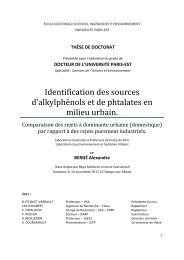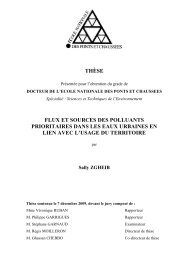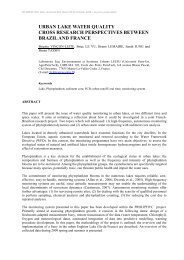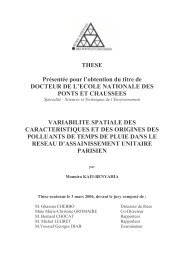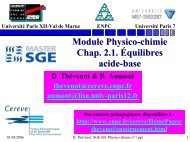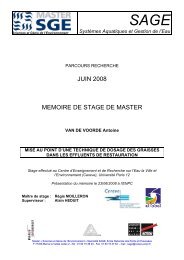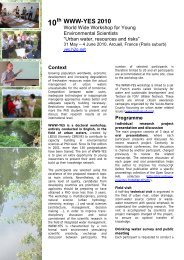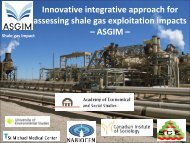that damage to soil was a risk from water reuse yet none of the organisations considered thatwater management to reduce this risk was a priority for sustainable development of agricultureusing wastewater. The organisations instead spoke frequently of the importance of monitoringto check for adverse effects from irrigation with wastewater. They spoke of a need to trainfarmers how to manage this water and of the need for more research to provide information todecision makers. All the organisations considered water reuse to be important because of thelimited availability of water and its corresponding importance for Jordan's water strategy.Only 7.5 per cent of organisations spoke of the positives from water reuse such as the nutrientbenefits.An issue of considerable importance in Jordan is the allocation of water to differentagricultural types and geographical localities and particularly the potential conflict between thedirect and indirect water re-users. This was identified by several of the organisations workingto develop agriculture in the international and NGO sector.“But then there's another challenge coming up. Because the (waste) water quality isbetter the farmers upstream are more interested in it so it could happen that the waterdoesn't even reach the Jordan Valley. Although the farmers (in the JV) have their waterrights. This is a bad thing for the livelihoods of the farmers, and also you have to askwhy invest in uphill farming when there's no farming there at the moment. Thisthreatens groundwater resources and damages the good market advantage that theJordan Valley has during the winter. Because the uphill farming is summer farming.They don't get as much money as the farmers in the Valley as there's a market gap there.It's always an economic decision what or where the water is used. And if they come upwith these ideas of growing industrial crops it would be a disaster.”“The water that comes from the Kirbet As Samra means that agriculture can continue inthe Middle Jordan Valley. And if this stops the situation will be very bad, I cannotimagine, because there is no water for agriculture. And even from a social andeconomic point of view, water here, is the only guarantee for the sustainability ofagriculture.”It would seem that the topic of water allocation between the indirect and direct agriculture isworthy of serious discussion by planners and decision makers.discussion as there are disadvantages and benefits of each system.REFERENCESAyers, R.S., Westcott, D.W. (1985). Water Quality for Agriculture. Irrigation and DrainagePaper, 29, Rev 1. FAO: RomeFAO Aquastats, (2008). http://www.fao.org/nr/water/aquastat/countries/jordan/index.stmAccessed March 2008Kitchin, R. and Tate, N.J. (1999). Analysing and interpreting qualitative data. In: Conductingresearch in human geography: theory, methodology and practice. pp 229-256 Prentice HallPatterson, R.A. (2001). Wastewater quality relationships with reuse options. Water Scienceand Technology, 10, 147-154Rowell, D.L. (1994). Soil Science. Methods and Applications. Pearson Education: UKRebhun, M. (2004). ‘Desalination of reclaimed wastewater to prevent salinisation of soils andgroundwater’, Desalination 160, 143-149Rebhun, M. (1965). “Salinity increments in municipal sewage, their significance and sourcesand methods of reduction’. International Journal of Air and Water Pollution, 9, 253-261Šimnek, J., Th. van Genuchten, M. and Šejna, M. (2005). The HYDRUS-1D SoftwarePackage for Simulating the One-Dimensional Movement of Water, Heat, and Multiple Solutesin Variably-Saturated Media. Department of Environmental Sciences, University of CaliforniaRiverside, CaliforniaVallentin, A. (2006) Agricultural Use of Reclaimed Water - Experiences in Jordan. WaterPractice & Technology 1(2) doi:10.2166/WPT.200604Water Authority of Jordan (2006). http://www.waj.gov.jo/English/left/faq.htm AccessedMarch 2008Winpenny, J.T. (2000). Managing water scarcity for water security. http://www.wcainfonet.org/servlet/BinaryDownloaderServlet?filename=documents/1354.Managing_water_scarcity_for_water_security.2001-11-13.pdf&refID=1354 FAO. Rome. Accessed 9/1/2007CONCLUSIONSThe interdisciplinary work allows us to draw several conclusions with regards to thesustainability of water reuse. The soil analysis has shown that water reuse for irrigation doesalter the soil salinity but it is very important to notice that the salinity changes are highlydependent on several factors such as the quantity of water applied, the rainwater inputs andespecially the management methods used on the farm. For this reason it is very important thatlaboratory results and field experiments are not extrapolated directly to the farm. It is essentialthat the farmer's knowledge, his perception of the water and the management methods that hechooses to apply are considered when assessing the effects of water reuse on soil. Thedecisions make by stakeholders away from the farm are also very important in the sustainablemanagement of water reuse and it seems that many organisations do not realise their role inmaintaining soil productivity through water management off the farm. It is expected that waterreuse for irrigation will increase in the future as greater volumes of urban wastewater areproduced, collected and treated. The allocation of this water between direct reuse aroundtreatment plants and indirect reuse at distance from the plants is worthy of considerableWWW-YES 2008, Paris 13 – 16 May 2008 137WWW-YES 2008, Paris 13 – 16 May 2008 138
INTRODUCTION16 Evaluation of industrial wastewater propertiesand microbial diversity to improve powergeneration in Microbial Fuel CellsSharon B. Velasquez Orta, Keith Scott and Thomas P. CurtisSchools of Civil Engineering and Chemical Engineering, Newcastle University,Newcastle upon Tyne, NE1 7RU, UK(E-mails: s.b.velasquez-orta@ncl.ac.uk, t.curtis@ncl.ac.uk, k.scott@ncl.ac.uk )AbstractMicrobial Fuel Cells can be used to generate electricity from organic matter present inindustrial wastewaters. This study compared four different types of industrialwastewaters (bakery, brewery, paper and dairy) for bioelectricity generation. Therelationship between wastewater characteristics, bacterial diversity and power outputwas determined. Paper wastewater produced the highest current yield (0.25 mA), atleast five times higher than dairy (0.05 mA), brewery and bakery wastewaters (0.02mA). Such high current production was independent from the substrate degradabilitymeasured as chemical oxygen demand. A comprehensive study was conducted todetermine the key difference driving current production for the paper effluent versusothers. Results from the microbial diversity revealed that bacteria specificallydeveloped in MFCs according to the type of wastewater used. Electrochemical analysisby cyclic voltammetry showed than the MFC operated using paper wastewaterproduced an electron shuttle compound with a red-ox potential of -0.12 V vs NHE. Itwas also proven that the paper wastewater bacteria producing the electron shuttlecompound were able to be transferred to MFCs using brewery and dairy wastewaterresulting in a six times improvement in current generation.KeywordsIndustrial wastewaters, anaerobic treatment, electron shuttle mediator, microbial fuelcells, microbial diversityWastewater treatment is a worldwide requirement to ensure community sanitation andconservation of natural resources. It is reported that over 10 billion litres of wastewater aredaily produced by England and Wales requiring approximately 6.34 Gigawatt hours of energy(POST, 2007). As wastewater production increases and discharge standards become stricter,conventional wastewater treatments demand more energy. The application of technologies thatcan generate energy from sewage is a possible solution to reduce energy consumption andincrease sustainability.Wastewater is potentially useful for generating energy since it is rich in organic matter.Obtaining methane as biogas from sewage or sludge is a widely-practised technology forenergy production (Lastella et al., 2002, Aiyuk et al., 2006). Other alternatives that have beenexplored are hydrogen or ethanol production from sewage (Venkata Mohan et al., 2007,Hipolito et al., 2008). An alternative wastewater treatment technology to directly generateelectricity from wastewater is Microbial Fuel Cells (MFC). MFC have the advantage toovercome storage and further processing of fuels (methane, hydrogen or ethanol) decreasingnumber of operations. However their application is regarded as to complement rather thansubstitute other anaerobic treatment processes (Pham et al., 2006). MFC technology usesmicroorganisms as catalysts, to produce electrons from organic matter. The reactorconfiguration used is similar to a fuel cell system with a proton exchange membrane dividingan aerobic and anaerobic chamber. Each chamber contains an electrode called “anode” for theanaerobic chamber and “cathode” for the aerobic chamber. Wastewater flows through theanaerobic chamber where microorganisms oxidize the organic matter producing electrons,protons and carbon dioxide. Electrons are collected by the anode of the MFC, and protonsmigrate to the aerobic chamber through the proton exchange membrane (Rabaey et al., 2004,Lovley, 2006). Electrons pass through an electrical circuit generating energy, and merge in thecathode with oxygen and protons generating water (Davis and Higson, 2007). By-products ofthe process are mainly: water and carbon dioxide.MFC have proved to be able to produce energy from wastewater effluents with high organicmatter content, such as sanitary wastes, food processing wastewater, swine wastewater andbeer processing wastewater (Du et al., 2007) indicating that MFC are suitable to treat a varietyof sewages. However, very little attention has been given to the MFC limitations imposed bythe substrates used and direct literature comparisons are difficult, due to the different reactorconditions used. Wastewater characteristics affect the rate of organic matter degradability andthe microbial ecosystem; as a consequence the rate of bacterial electron transfer and the overallMFC process efficiency are defined. The determination of how wastewater characteristicsaffect the anaerobic chamber mechanisms will increase the understanding of the mechanismsaffecting electron shuttle rates and will allow exploring alternatives for the MFC control andoptimization according to the type of wastewater used.In this work we studied and compared the effect of using different industrial wastewaters(bakery, brewery, paper and dairy) in bioelectricity generation from MFC using identicalsingle chamber reactors. The relationship between different wastewater characteristics,bacterial diversity and power output was determined.MATERIALS & METHODSMFC assembly and operationEight novel single chamber MFC reactors were constructed. Reactors consisted of a 45 mlanaerobic chamber with a carbon cloth anode in one side of the chamber. In the opposite sidethe cathode was assembled with an open gate to use oxygen from air. The cathode was madeof 20% wet proof carbon toray paper coated with a gas diffusion layer consisting of KetjenBlack (1.5 mg/cm 2 ) and 10%wt PTFE, and, a layer of Pt (5 mg/cm 2 ). A proton exchangemembrane was assembled to the cathode by hot-pressing (130 o C, 1500 kg/cm 2 ) for 5 min. Tocollect electrons and protons a stainless steal mesh was used in the cathode external side.Anode and cathode were connected using a stainless steal wire and an external resistor boxfixed at 1000 ohms (closed circuit). Before use, all reactor components were autoclaved and/orsterilised for at least 15 min. MFC were sampled and refilled using a sterile syringe, through aseptum installed in the top of the reactors. MFC were operated all the time in batch mode andat closed circuit except when polarizations and cyclic voltammetry experiments were done(cells were at open circuit). Samples collected from reactors were immediately stored at -20 o C.Inoculum and wastewater samplesExperiments were done in duplicates using four different effluents sampled from bakery,brewery, paper and dairy industries located in the North East England, UK. Immediately aftercollection, wastewater samples were stored at -4 o C. Before use, wastewater samples wereadjusted in terms of COD (around 600 mg/L) by diluting some wastewater streams withWWW-YES 2008, Paris 13 – 16 May 2008 139WWW-YES 2008, Paris 13 – 16 May 2008 140



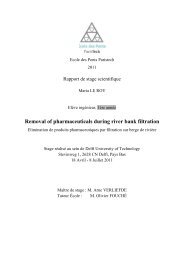
![[pastel-00730831, v1] Incidence des pratiques d'entretien ... - LEESU](https://img.yumpu.com/50938896/1/184x260/pastel-00730831-v1-incidence-des-pratiques-dentretien-leesu.jpg?quality=85)

